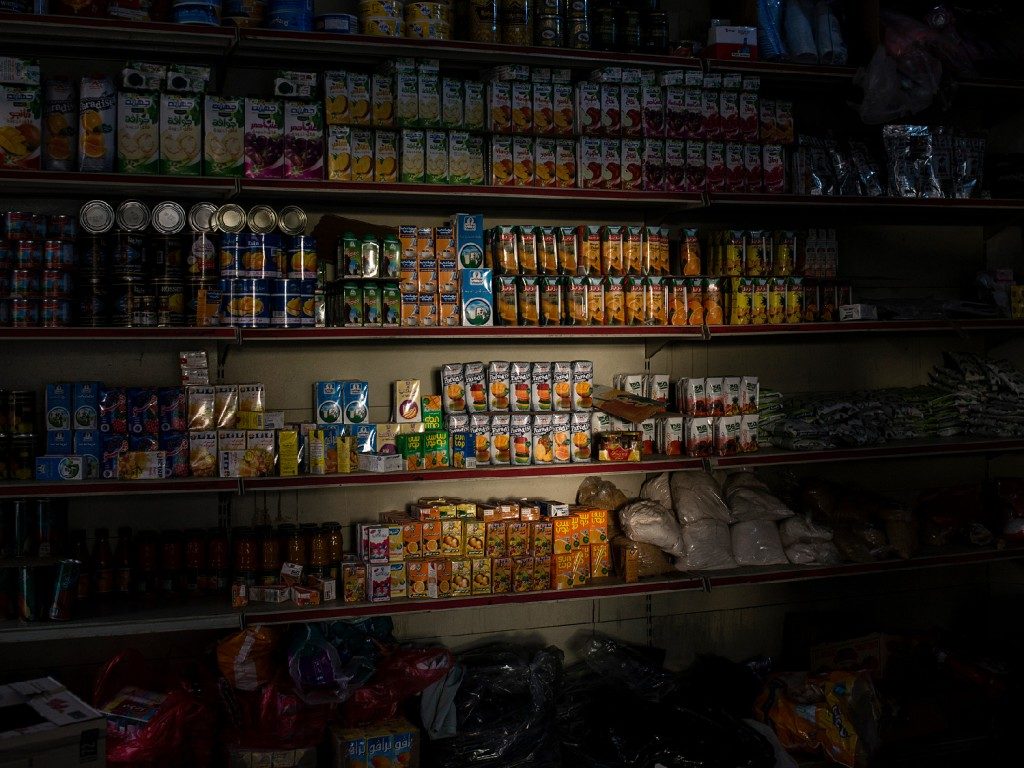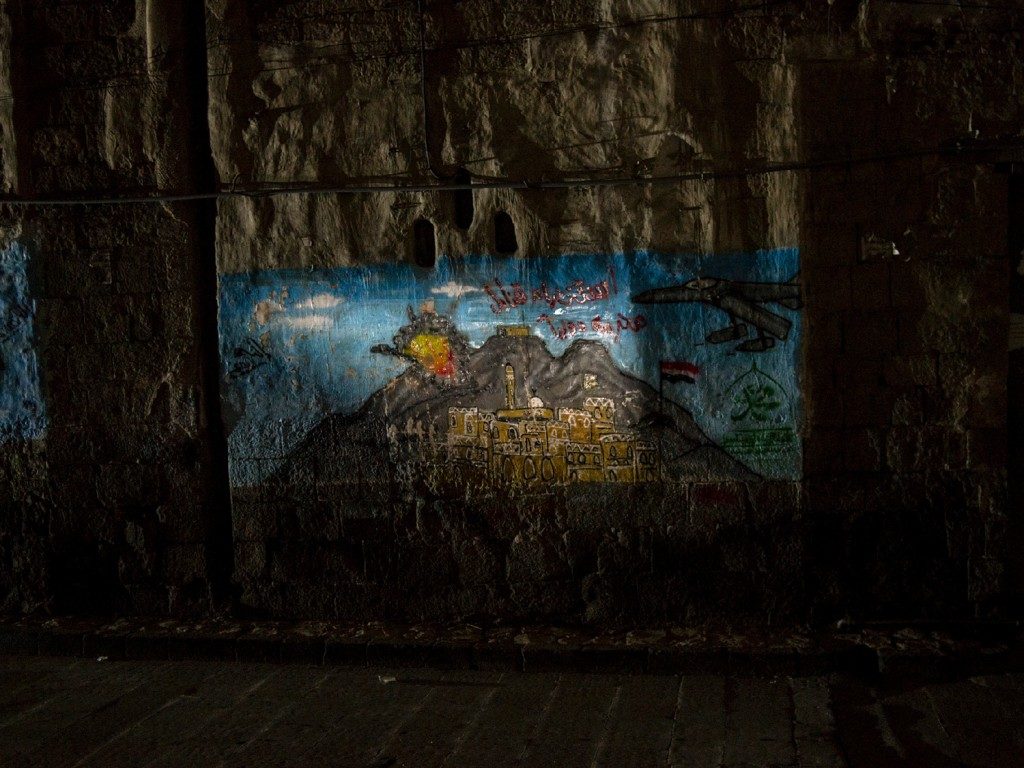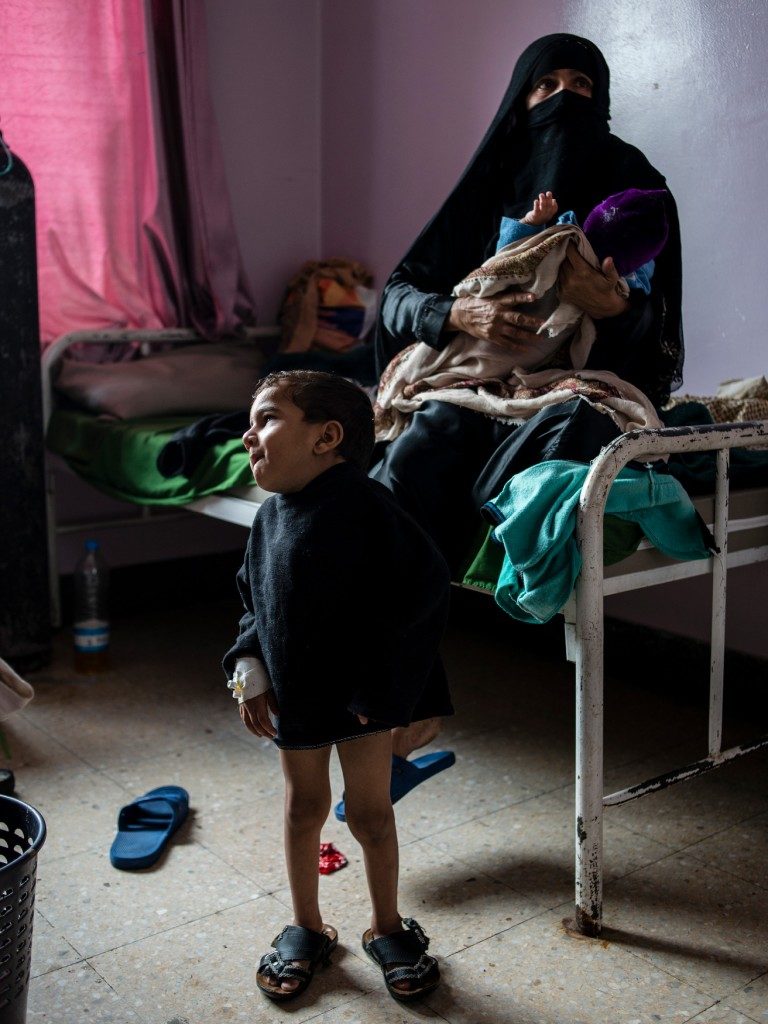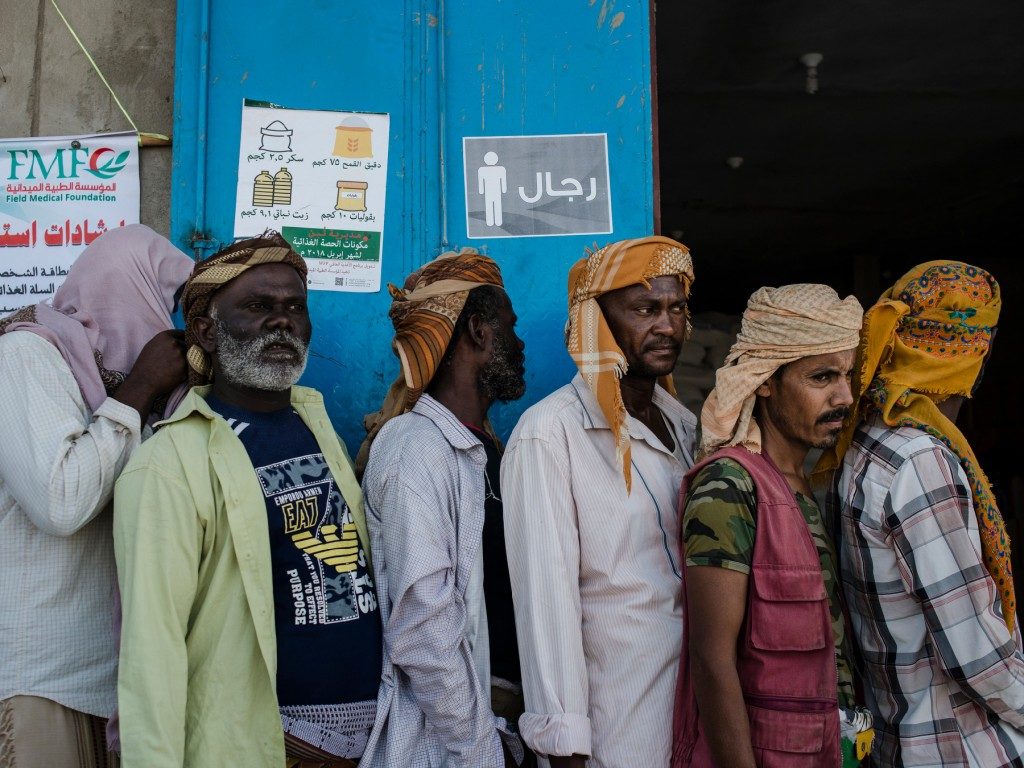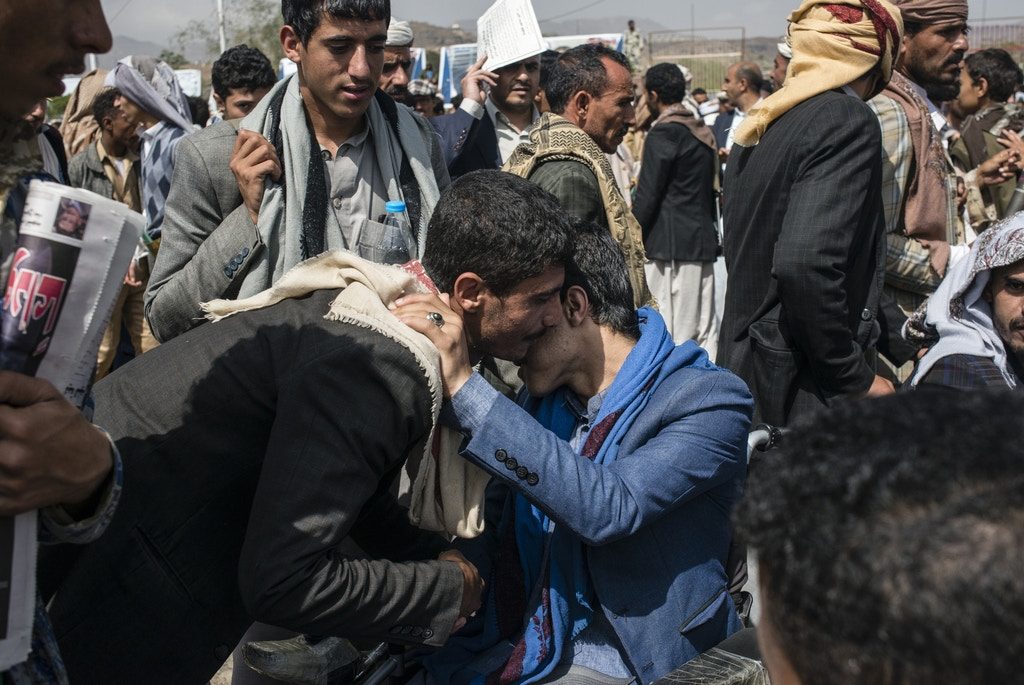Yemen: She Named Her Child “Enough”
MIDDLE EAST AND NORTH AFRICA, 25 Jun 2018
A Rare Look at Yemen’s War, Where Children Starve and Hospitals Are on Life-Support
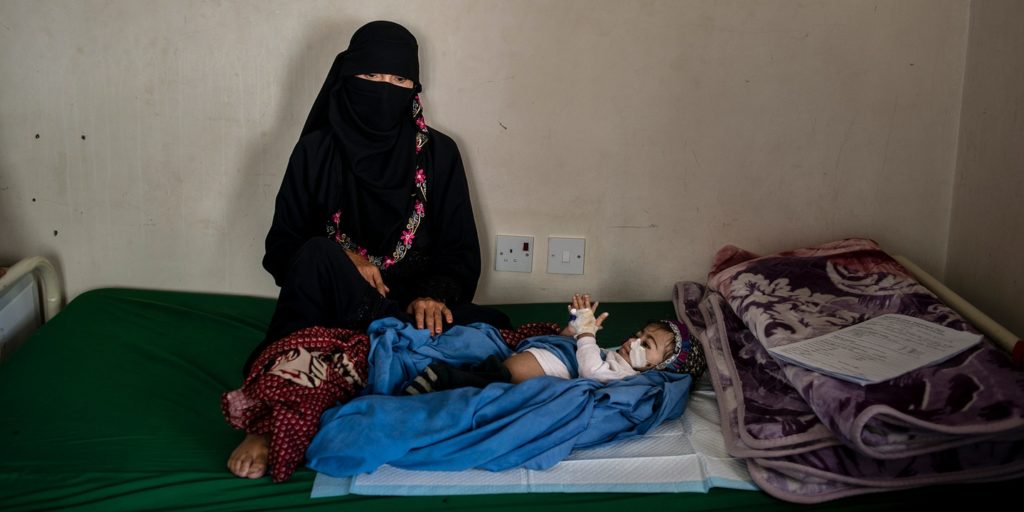
Kafaya, whose name means “enough,” sits in the arms of her mother on May 7, 2018, in Bani Mansur, Yemen.
Photo: Alex Potter for The Intercept
21 Jun 2018 – The changes that three years of war have wrought on Sanaa are subtle and, at first, easily overlooked. The northern Yemeni city isn’t destroyed, but rubble from airstrikes remains in certain neighborhoods. People’s clothes aren’t in tatters, but men these days prefer colored robes instead of the traditional white, so they don’t have to launder them as often. All of the different types of Yemeni bread, from long, thin roti to flat rashoosh, are smaller, and food vendors in the market portion out their goods exactly in plastic bags, rather than throwing in some extra for good measure. More people walk in the streets, instead of spending a few riyals on a bus, or more on a taxi. At home, women make bread in wood stoves, rather than gas ovens, since the price of gas is over 10 times what it was before the war.
The front-line battles are far from Sanaa, but the entire north is suffering the consequences of a blockade by the Saudi-led coalition fighting the Houthi forces that have controlled the region since 2014. No civilian flights are allowed from the Sanaa airport, and international aid is often stopped and delayed. In addition to the skyrocketing price of goods, the Yemeni riyal has dropped from 250 to 450 on the dollar. The resulting economic crisis from the loss of jobs and trade has left 80 percent of the population in need of humanitarian aid, most often in the form of financial support and food. The markets are full, but no one is buying. Many Yemeni families go hungry, subsisting on only one meal a day, and while there is no outright famine, familiar faces, once full of life, are now hollow and drawn with worry.
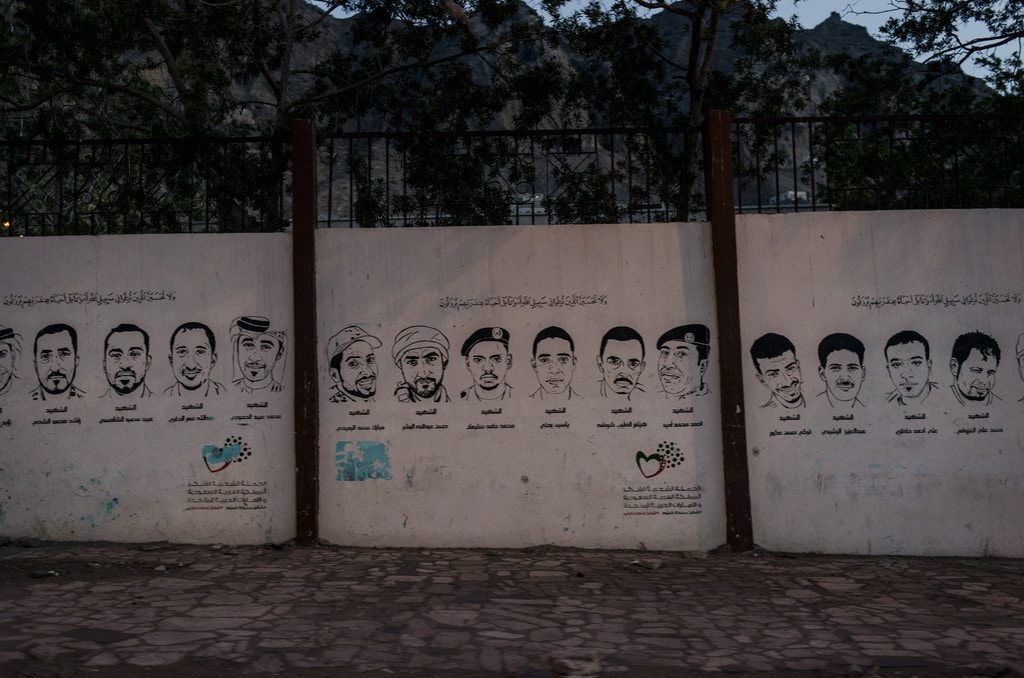
Images of Yemenis killed in the 2015 battle against the Houthis are painted on the walls of main streets in Aden, Yemen. Photo: Alex Potter for The Intercept
Since March 2015, the Iran-allied Houthis and other factions in Yemen have been entwined in a civil and international war with Saudi Arabia and its coalition partners, who are fighting to restore the government that the Houthis overthrew. Coalition airstrikes — supported by refueling, munitions, and intelligence from the U.S. military — have pummeled not only Houthi military positions, but also homes, schools, business, and essential infrastructure in an attempt to bring Yemen to its knees. The strikes have often been indiscriminate, and Saudi Arabia has been accused by Human Rights Watch of war crimes. Last week, the port city of Hodeidah came under attack by pro-government forces backed by coalition partner the United Arab Emirates, threatening to plunge the country deeper into humanitarian crisis. At least 10,000 civilians have been killed during the war, although many deaths go unreported, and the true number is likely much higher.
Ordinary Yemenis have suffered in many other quieter ways. Those with chronic illnesses are dying in droves. With limited access to dialysis, chemotherapy, diabetes medications, and supplemental feeding for malnourished children, and almost no possibility of leaving, poorer families are simply giving themselves up to fate.
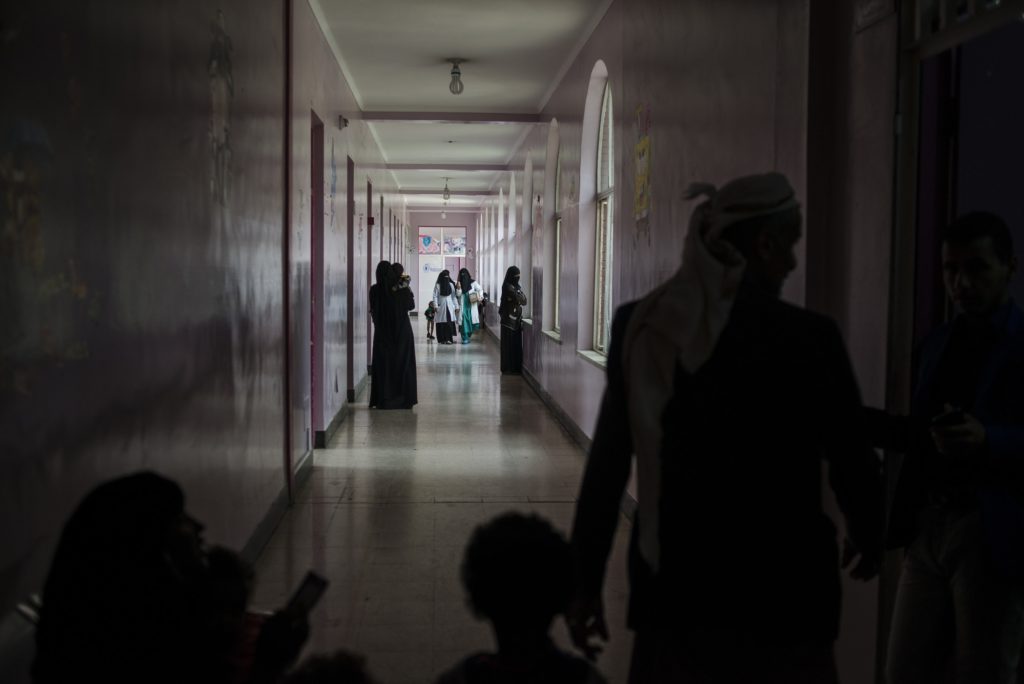
Yemeni families and nurses walk through the malnutrition wing at Sabaeen Hospital in Sanaa on May 4, 2018. Most hospitals in the north are functioning at a minimal levels, constantly short on supplies, while their staff have remained unpaid for months. Photo: Alex Potter for The Intercept
Stunted by War
Sabaeen Hospital, on a main road near a mosque in Sanaa, is the final stop for severe cases of malnutrition in children. Most families come here from rural areas where the closest basic health facility may be over two hours away. Those who can afford to travel to Sabaeen bring little with them — only a few changes of clothes and the hope that their infant or toddler will survive.
Ali Qasim al-Ajil held his daughter Kawthar, a pale and lethargic 6-month-old, dressed in layers of bright clothing to keep her warm. The family is from Bani Hushaish, a two-hour drive from Sanaa.
“It started with cholera, right after she was born,” al-Ajil said. “Since then, she hasn’t been able to nurse; her mother also hasn’t had enough to eat, so she didn’t give any milk. We’re all farmers in our area. We can barely afford flour and gas. No one has work since the war started. Life is so expensive.”
In the next room, 9-month-old Bushra cried on the bed next to her mother. Her limbs were thin and her ribs prominent, but her belly was swollen, a sign of electrolyte imbalance. Thin blue veins were visible beneath her pale skin. Like Kawthar, she couldn’t breastfeed. She had been in the hospital for a month, but had made little progress, growing from 6.6 pounds to 8.1.
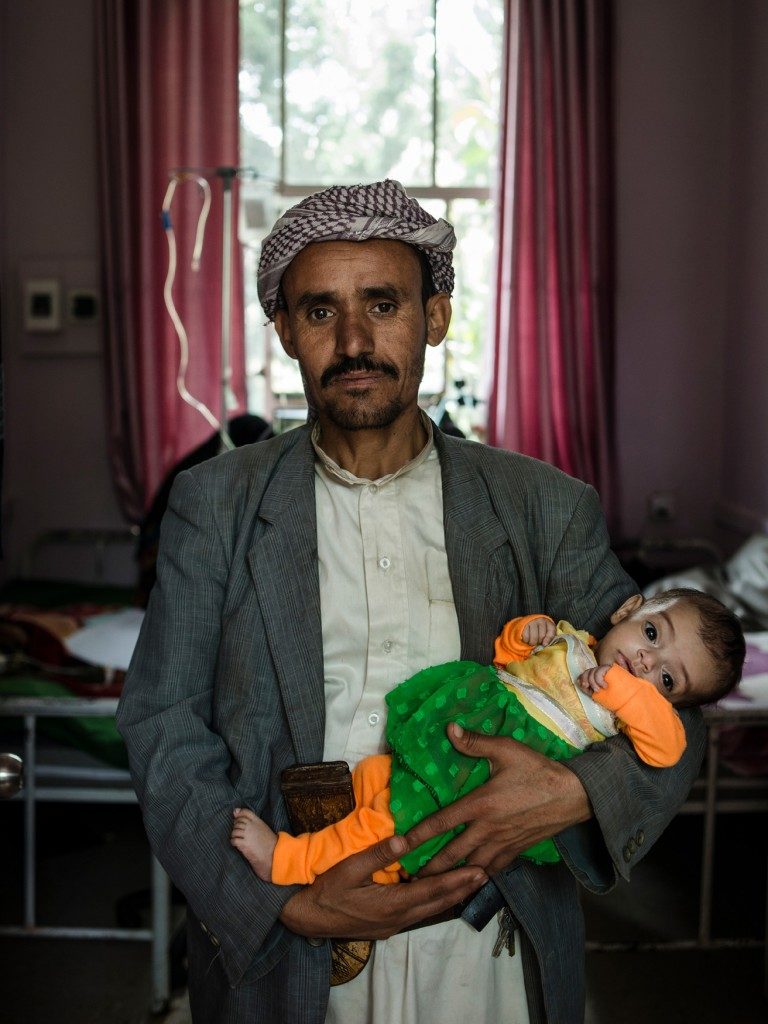
Ali Qasim al-Ajil holds his malnourished 6-month-old daughter, Kawthar.
Photos: Alex Potter for The Intercept
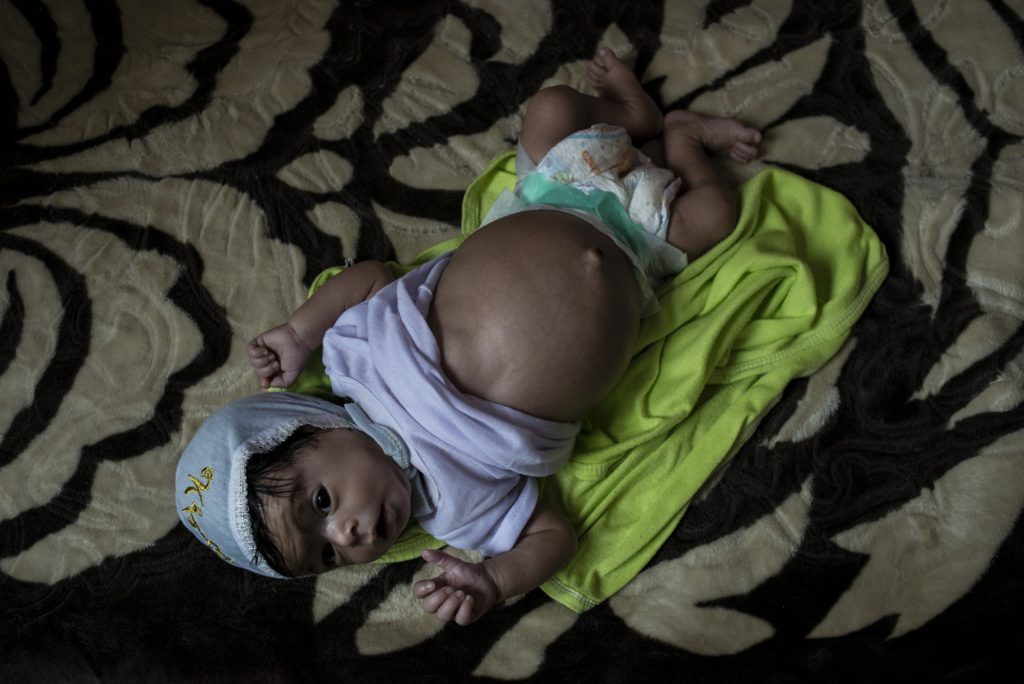
Nine-month-old Bushra lies on a bed, belly bloated from electrolyte imbalance and malnutrition. Photo: Alex Potter for The Intercept
Six-year-old Ahmad Ghalib stood next to his mother, mouth agape and eyes wandering, knees knocking together. Ahmad is from a small village in Amran, north of the capital, and his mother claimed that doctors said his mental handicap was due to chronic malnutrition.
“He didn’t eat well from the day he was born, but for the last three years, it’s been very bad. We couldn’t afford to vaccinate him. … He’s been here for 20 days, but there’s no point in staying. We’re going home tomorrow,” she said.
UNICEF estimates that nearly 400,000 children in Yemen suffer from severe acute malnutrition and nearly 2 million are chronically malnourished, a condition that causes stunting and physiological and psychosocial delay. The children who do survive will likely feel the health impacts of those delays for the rest of their lives.
At a center supported by the World Health Organization in Bani Mansur, a village outside Sanaa, a 1-year-old Yemeni girl with beautiful eyes and long lashes sat listlessly in her mother’s arms, a feeding tube taped to her cheek.
“When she was born, I was so tired,” said the mother. “That’s why I named her Kafaya — it means ‘enough.’ I have 12 children; I’ve had enough, and we are all exhausted from the conflict. We have had enough of this war.”
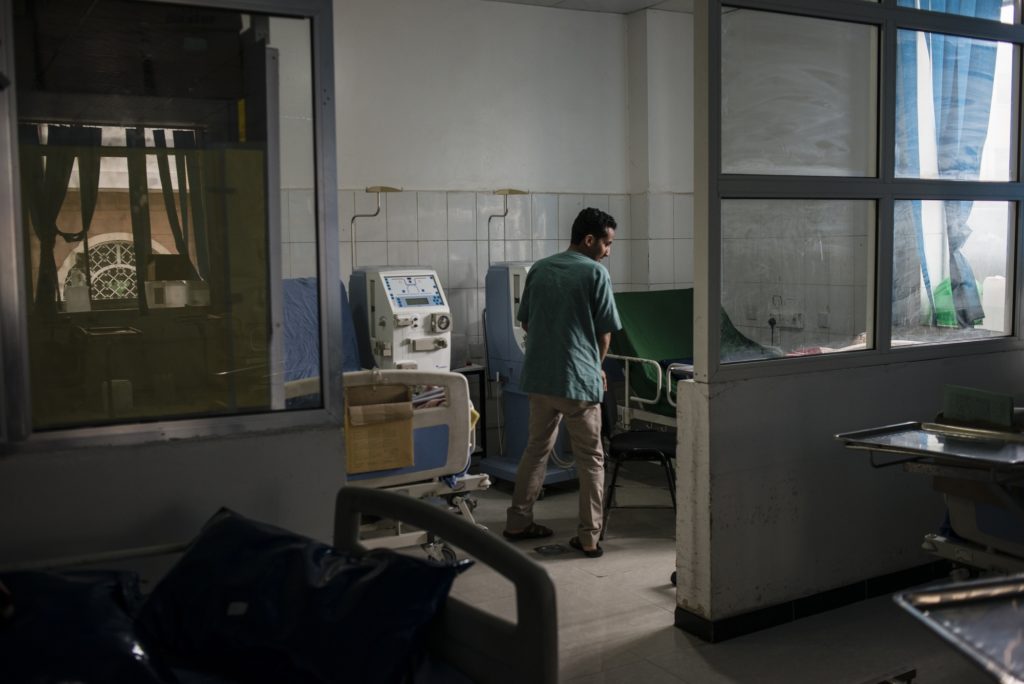
Dr. Majed al-Qadasy at Jumhuri Hospital in Sanaa on May 4, 2018. Al-Qadasy is responsible for the dialysis program at the hospital. Photo: Alex Potter for The Intercept
Hospitals on Life-Support
At Jumhuri Hospital in Sanaa, the main referral center for patients with kidney failure, Dr. Majed al-Qadasy faces a failing dialysis situation.
“We were supposed to close just last week; we were completely out of supplies,” al-Qadasy said. “[The International Committee of the Red Cross] helped us out so we could stay open. Our patient quota is supposed to be 70 patients per day; we’re now treating over 100 on the weekdays. But the big problem is our staff has no salaries.”
“We’re working double time and haven’t had any real pay for years now,” he continued. “Our doors are always open to those who need help, but we don’t know how much longer we can keep going.”
Upstairs in the recovery wing, al-Qadasy spoke with Ahmad Mohammad Morshid. The 33-year-old farmer and qat seller from a rural village in Dhamar waited months to get dialysis when his kidney failure started — he simply couldn’t afford the treatment. When he arrived at the hospital, emaciated and belly swollen, he was nearly dead. After a single treatment, he had the strength to sit up in bed.
“We’re poor people. I’m just a farmer and can barely afford to feed my four kids — why should I worry about myself?” he said. “My family had to take out a loan just to get me here, now I’m supposed to stay here for treatment?”
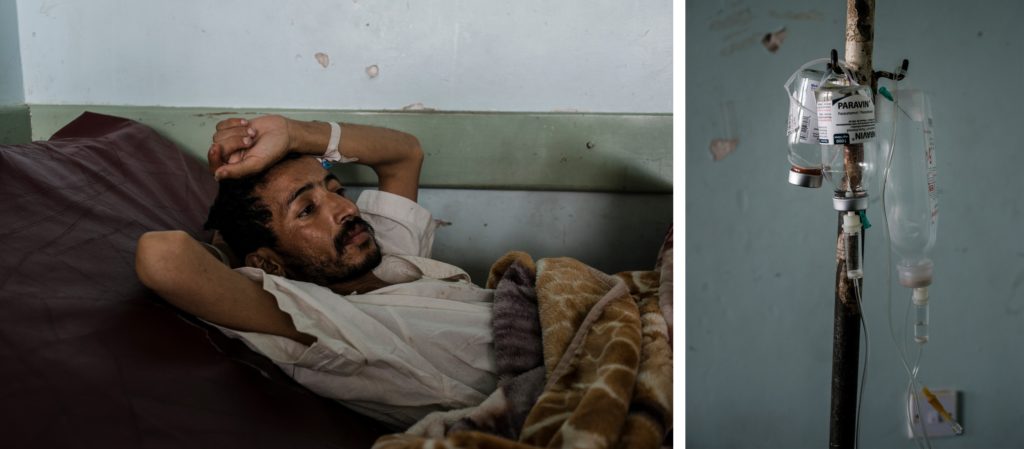
Ahmad Mohammad Morshid, who recently underwent his first round of dialysis for kidney failure, recovers in his bed on May 4, 2018, at Jumhuri Hospital. Photos: Alex Potter for The Intercept
Some Yemenis who have managed to maintain their wealth support local organizations like Dar al-Shafaqa, or “House of Compassion,” which gives chronically ill Yemenis from rural areas a dignified place to live during their treatment. The unassuming building on a side street in Sanaa houses over 100 Yemenis with cancer and kidney failure.
Dr. Waleed Mohammad, the head of the nongovernmental organization, said that in his experience, “much of Yemen’s humanitarian crisis plays out privately. I’ve seen couples get divorced because the man feels ashamed he can’t take care of his wife, he can’t even feed himself. With those who can’t afford treatment or travel, even some from this center, they give up. They return home to die, rather than burden their families with the cost of therapy.”
Two young boys, Abdo and Bashir, kicked a ball around the yard, wearing hats to cover their lack of hair from chemotherapy. An elderly man from Mahwit with kidney failure wandered the halls, talking to other boarders. Upstairs in the women’s wing, three separate rooms were full of women who have cancer; they were wrapped in heavy blankets, some silent, some moaning, all accompanied by a mother, daughter, or aunt tasked with looking over them until they return home, either recovered or to die.
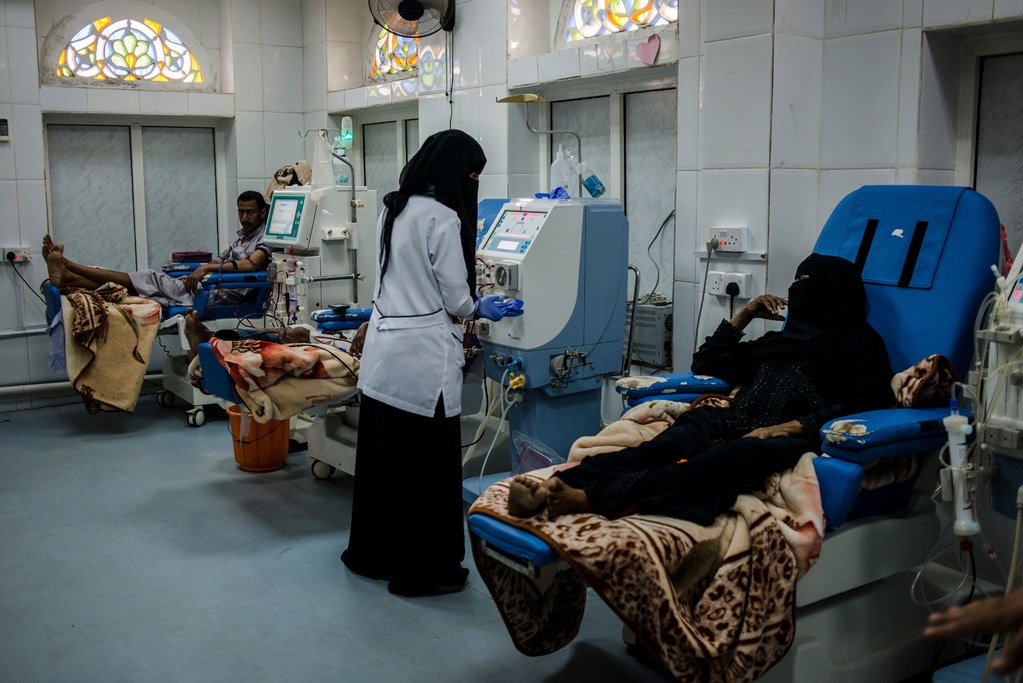
Yemeni nurses tend to kidney failure patients on dialysis in Hajjah, Yemen.
Photo: Alex Potter for The Intercept
Over winding mountain roads three hours northwest of Sanaa, Sultan Masood, a 28-year-old nurse, runs the dialysis center at Jumhuri Hospital in Hajjah City. Before the war, he said, his hospital treated 250 regular patients. Last year, because other centers in the region have been destroyed, they saw 900.
Masood believes the compounding factors of war create more chronic illness. “The airstrikes are stressing out people’s systems, cholera and diphtheria are just adding to it,” he said. “Eight of our regular clients died last year. We called them to ask why they’re not coming any more, and they said they can’t do it anymore. They just gave up on life.”
Officials and humanitarians are at a loss as to how to keep their hospitals running. Everyone in the health system dreads cholera season, which accompanies the arrival of spring rains. According to Masood, Jumhuri Hospital treated 8,000 cases last year in a six-month window, using a school for treatment when their facility was overrun.
“This hospital is operating at 130 percent capacity; as you can see, there are beds even in the hallway,” said Sally Thomas, project coordinator for Doctors Without Borders, which has a team working at Jumhuri. “We support the hospital in emergency and trauma, trying to improve the quality of care, but things are extremely difficult. Follow-up care with patients is nearly impossible because many poor families have no way to communicate or money to get back here.”
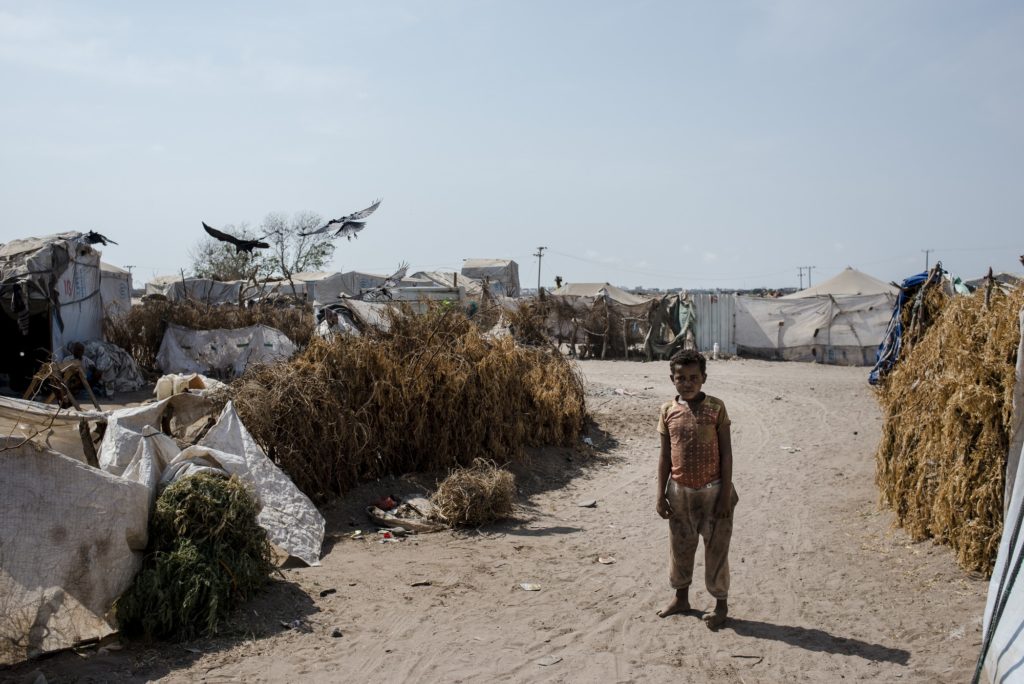
A Yemeni boy walks through the sand back to his tent in Mishqafa Camp on April 23, 2018. Most of the families in the camp come from impoverished areas near the front line, but the camp is also destitute.
Photo: Alex Potter for The Intercept
Forced to Flee
The north has received the brunt of coalition airstrikes and the blockade, but the humanitarian situation is dire across the country. Thousands of Yemenis have fled south from front line areas in Hodeidah and Taiz, where Houthis battle various local factions supported by the coalition. Many of them have ended up outside desert villages in Lahij, just north of Aden. While some families have managed to move in with relatives, poorer families and those from the darker-skinned muhamasheen class, who often face discrimination, have taken refuge in makeshift settlements with little support from international NGOs.
In Mishqafa camp, the local sheikh responsible for the area said that 265 people live in horrendous conditions: There is no running water or electricity, no school or health care facility. Tents are haphazardly tossed together with tarps, rope, brush, and branches, with clay stoves made by hand just that morning baking out in the sun. Sheikh Zaky claimed the camp is supported with funds from UNICEF, the U.N. humanitarian agency, and the World Food Programme, but if those international aid groups are present, their support isn’t visible.
“We [local villagers] are trying to help these people. They are our neighbors. So we’re trying to arrange more distributions through a local NGO,” said Zaky.
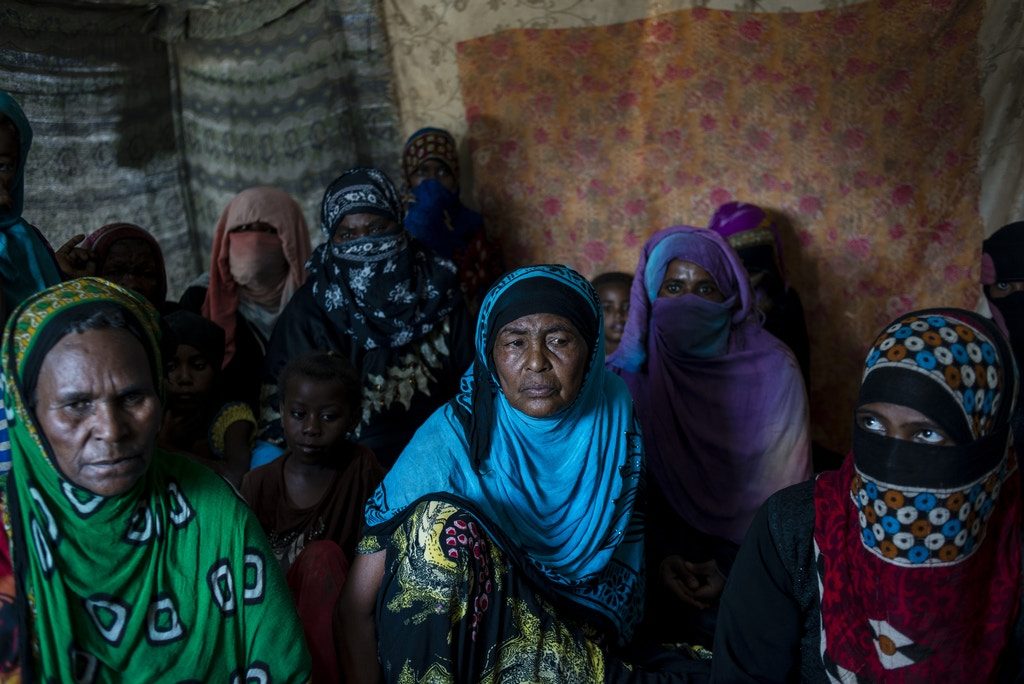
Yemeni women from the Warazan area of Taiz sit in a tent to escape the sun on April 23, 2018, in Mishqafa camp. Photo: Alex Potter for The Intercept
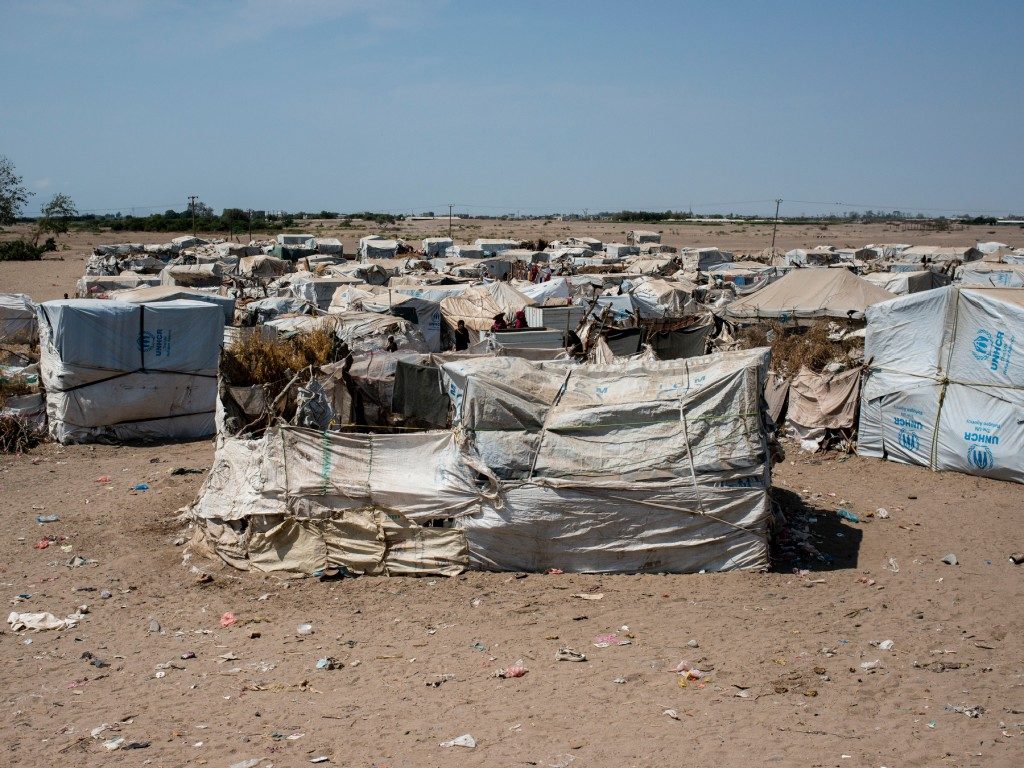
Makeshift tents held together with rope and protected by sticks bake under the sun in Mishqafa camp. Photos: Alex Potter for The Intercept
Dozens of women who had fled from Warazan, a village near Taiz and the site of an active front line, crowded into a tent to share their stories. Most had been in the derelict camp for two years, having escaped by bus in the middle of the night to flee the fighting.
An elderly woman in a blue headscarf named Kharifa spoke up. “We ran away from the mortars. Our houses were destroyed, yes, but also because we had nothing!” she said. “Our wells and markets were destroyed; there was no way to get across the front line to buy food. We hear there is still fighting there, so we won’t go back, even if we have to live like this in the desert.”
Men in the makeshift camps attempt to get work in neighboring villages, and many go each week to a food distribution organized by the World Food Programme to get flour, pulses, oil, gas, and rice for their families. The majority of the families were poor to begin with: laborers, fishers, or street sweepers. None of them see returning home as an option while fighting goes on in their villages.
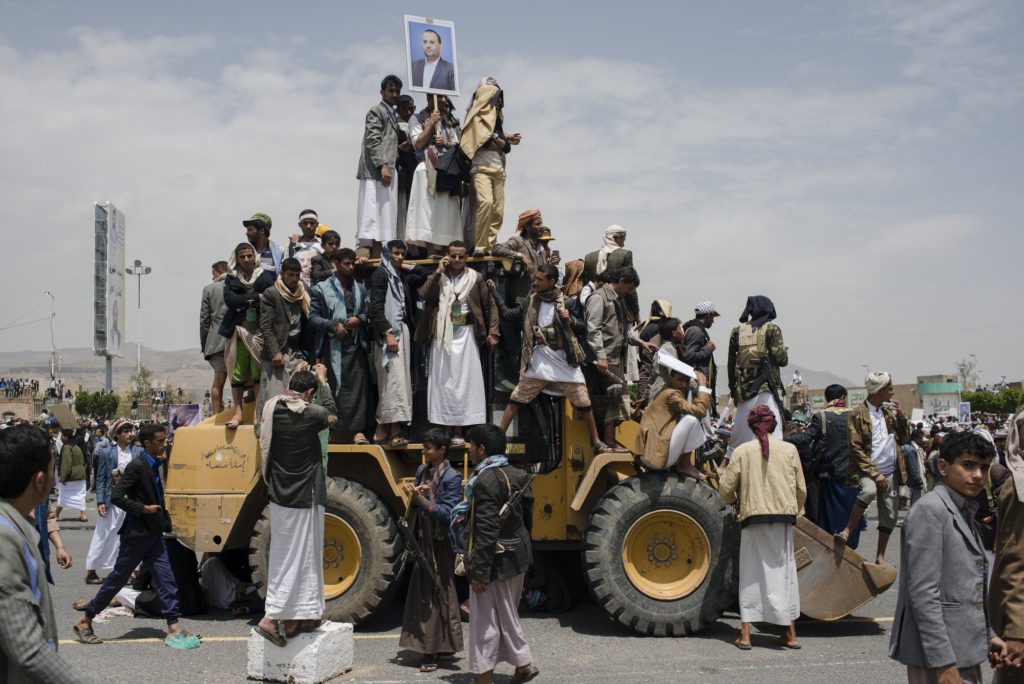
Supporters of the Houthis gather for prayer on April 28, 2018, ahead of the funeral of Saleh al-Samad, a Houthi political leader who was killed in an airstrike. Photo: Alex Potter for The Intercept
A Strike in Sanaa
On April 28 in Sanaa, thousands of Houthi supporters gathered for the funeral of Saleh al-Sammad, the head of their political council, who had recently been killed in an airstrike. Men gathered to pray and protest, filling the width of 70th Street and the courtyard of “the People’s Mosque” (once “Saleh Mosque” after the former president, but renamed after he changed sides in the war and was killed for his betrayal). Just as the speeches finished and prayer was set to begin, jets flew overhead, and an airstrike hit nearby, followed by another. The bomb hit nothing of consequence, so it had to be a warning — a reminder that the coalition was always watching the city. Unaffected, the protesters did not run. Rather, they stood and chanted their now well-worn, infamous “Death to America” slogan. One elderly man grabbed another and said, “We are Yemenis! We don’t run away from bombs, we run toward them!”
Yemenis are resilient, with a strong social structure where neighbor supports neighbor, and friend supports friend. Years of airstrikes, front-line fighting, displacement, and shortages have not ended the war, as the Saudi-led coalition assumed they would. But despite their defiance, the conflict has brought Yemen to a point where its citizens can’t even obtain basic needs, and the nation is weary.
__________________________________________________
This story was supported by Women Photograph and the Pulitzer Center on Crisis Reporting.
 Alex Potter – alexkaypotter@gmail.com
Alex Potter – alexkaypotter@gmail.com
Go to Original – theintercept.com
DISCLAIMER: The statements, views and opinions expressed in pieces republished here are solely those of the authors and do not necessarily represent those of TMS. In accordance with title 17 U.S.C. section 107, this material is distributed without profit to those who have expressed a prior interest in receiving the included information for research and educational purposes. TMS has no affiliation whatsoever with the originator of this article nor is TMS endorsed or sponsored by the originator. “GO TO ORIGINAL” links are provided as a convenience to our readers and allow for verification of authenticity. However, as originating pages are often updated by their originating host sites, the versions posted may not match the versions our readers view when clicking the “GO TO ORIGINAL” links. This site contains copyrighted material the use of which has not always been specifically authorized by the copyright owner. We are making such material available in our efforts to advance understanding of environmental, political, human rights, economic, democracy, scientific, and social justice issues, etc. We believe this constitutes a ‘fair use’ of any such copyrighted material as provided for in section 107 of the US Copyright Law. In accordance with Title 17 U.S.C. Section 107, the material on this site is distributed without profit to those who have expressed a prior interest in receiving the included information for research and educational purposes. For more information go to: http://www.law.cornell.edu/uscode/17/107.shtml. If you wish to use copyrighted material from this site for purposes of your own that go beyond ‘fair use’, you must obtain permission from the copyright owner.
Read more
Click here to go to the current weekly digest or pick another article:
MIDDLE EAST AND NORTH AFRICA:
